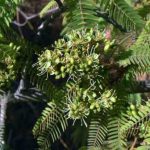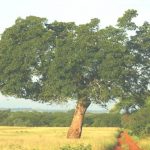TREE LIFE
January 1983
MASHONALAND CALENDAR
1st January 1983 : New Year’s Day. This brings the Greetings of myself and the Committee for a very Happy New Year and we hope that 1983 will be a happy year for you.
Tuesday January 4th : Botanic Garden Walk. Meet in the Car Park at 1645 for 1700 hours.
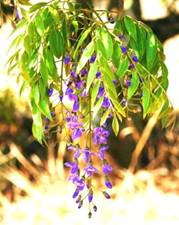
Bolusanthus speciosus. Photo: Bart Wursten. Source: Flora of Zimbabwe
Sunday January 16th : Selous, Serui River. 2nd crossing just beyond Selous, 76.5km along the Chegutu road. With an altitude of 1213m there is a combination of lower altitude and riverine vegetation. Trees such as Terminalia randii, small leaved Terminalia, Tarchonanthus camphoratus, wild camphor, Bolusanthus speciosus, wild wisteria are some of the interesting trees we do not often see. There are patches of mopane with that special atmosphere and I hope we shall lunch under an Afzelia quanzensis, Pod mahogany, with a trunk it will take at least three people with arms outstretched to measure the circumference.
Tuesday January 25th : ANNUAL GENERAL MEETING
Notice is hereby given that the 33rd Annual General Meeting of the Tree Society of Zimbabwe will be held on Tuesday 25th January 1983 at 2000 hours at the Selbourne.-Routledge School. Use entrance from Sir James MacDonald Drive.
Agenda: 1. Notice convening the meeting
- Minutes of the last AGM (attached)
- Matters arising there from
- Chairman’s Report
- Treasurer’s Report
- Amendments to the Constitution
- Election of Officers
- Any other business
- Film show
BOTANIC GARDEN WALK DECEMBER 1982
When the primary divisions of a pinnate leaf are themselves divided into pinnae then the leaf is called bi-pinnate. Very easy to find examples of trees which have bi-pinnate leaves are the Jacaranda and Spathodia which both belong to the family BIGNONIACEAES. There are not many indigenous trees in general which are bi-pinnate, Albizia; Acacia; Amblygonocarpus represented by A. andongensis, Scotsman’s rattle; Newtonia; Xylia; Elephantorrhiza entada; Erythrophleum; Burkea and Peltophorum, all members of the pod bearing family LEGUMINOSEAE but none of the indigenous BIGNONIACEAE trees are bi-pinnate.
It was Albizias which we looked at during our December Botanic Garden Walk Albizias are unarmed, without spines, although in Albizia anthelmintica the branchlets can end in a sharp point and in A. harveyi there is sometimes a prickle under the node. They always have glands on the petiole but not as I stated last time does the gland always occur in the middle of the petiole. My apologies, I obviously misunderstood.
The first species we looked at was Albizia harveyi, sickled leaved Albizia which usually occurs at lower altitudes in the woodland at the edge of pans, always on the deeper soil and if found at this altitude it must be on alkaline vlei soils. It is one of the three very small, or Acacia like, leaved Albizias. Its distinguishing features are a dark bark which is deeply vertically fissured, the red new growth and an asymmetric clearly visible midrib which divides the sickle shaped leaflets into two unequal parts. Albizia amara which we looked at much later has straight oblong leaflets and a much longer leaf. A pinna taken from the middle and measured against the rachis went along it 8 times. We did not go back and measure a pinna along the rachis of A. harveyi but judging from photographs there are 3 or 4 lengths of pinnae per rachis. Albizia brevifolia, an escarpment species, has a short rachis of only 2 pinnae lengths. The gland was rather difficult to see but we had no difficulty feeling it right in the middle of the petiole.
Albizia amara which often grows in groups and is the most common of the small leafed species has a smoothish bark and the new growth is tawny coloured. This can sometimes be confused with Peltophorum africanum, African wattle, but that has a fern like stipule and no glands on the petioles
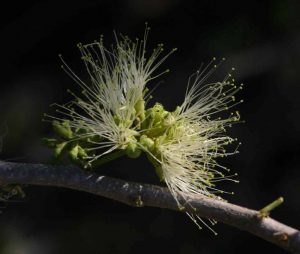
Albizia anthelmintica. Photo: Bart Wursten. Source: Flora of Zimbabwe.
Albizia anthelmintica, an inhabitant of the lowveld is a species I do not think we have encountered before. It has round leaflets, a little bit like Dalbergia melanoxylon. There are 2 to 3 pairs of pinnae with variable sized, opposite leaflets, the largest pair, up to about 2.5cm at the end and the smallest nearest the petiole. This is a characteristic of most of the larger leafleted Albizias. With its largest terminal leaflets markedly asymmetric and flowering for the first time was Albizia glaberrima, lowveld Albizia. This is very similar to our familiar friend Albizia antunesiana, purple leaved Albizia but which has terminal leaflets that are almost symmetric. The ones we looked at in the Botanic Garden did not have markedly larger terminal leaflets but those I have looked at since, have had. The very pale under surface of the leaves and the purple tinge which is often present are further distinguishing features and also help separate this species from Burkea africana which has maroon velvet tips to the branchlets, unicoloured leaves and probably lacks a gland on the petiole.
Associated with forests is another trio which are very similar, Albizia gummifera is an inhabitant of the higher altitude dry forest areas. It has a smooth bark, is glabrous (without hairs) and has a leaflet with a heel. The leaflet is almost rectangular and the midrib runs diagonally across but instead of starting in the corner it starts slightly up the side leaving a slight heel. Albizia adianthifolia has leaves with a midrib that starts in one corner and goes through to the other. The bark is rough and the leaves and pods are covered with yellow brown velvety hairs. This is a tree of lower altitudes, often a pioneer where regeneration is occurring. Albizia schimperiana is another pioneer colonizer in cleared forest. It grows in dryer type forests (we saw it at Murahwas Hill) and can become a very big tree. It has almost symmetrical leaflets with the midrib running through the centre and a slight petiolule (or leaflet stalk). Albizia petersiana was in flower with its red stars amongst the white rather lax and sparse powder puff. A feature it shares with A. adianthifolia and A. gummifera although its leaves resemble those of A. anthelmintica but are minutely roughly hairy. Albizia zimmermannii resembling Brachystegia glaucescens, mountain acacia in habit, occurs in the northern part of the country in the schist belt of the lower Mazowe River and in the Ditchwe Limestone Belt and has almost symmetric leaflets rather like A. schimperiana which only occurs in the east. It took quite a lot of searching both looking and feeling before we found the glands on A. zimmermannii but eventually enough leaves were examined to establish their presence.
Albizia versicolor, poison-pod Albizia, is well known for its poisonous pods. It flowers about November/December and the pods develop very slowly to ripen before the flowers appear again. If there is a high wind which dislodges them before they are ripe they have a high prussic acid content which is extremely toxic to cattle and sheep. This species has the largest leaves and the largest leaflets which are velvety. It also has the largest stipulule, shortened scientifically to stipel, which is a leaf like or scale like appendage at the base of a leaflet and is another characteristic of Albizias.
And when we got home and thought about it all we realized that we had not looked at the well known Albizia tanganyicensis, paper bark Albizia, which even when the paper has peeled off has a spectacular white trunk. Nor had we looked at the not very common Albizia forbesii which is a river bank species of the Sabi and Nuanetsi.
Thank you Tom for a fascinating evening enjoyed tremendously by only a few of us.
BULAWAYO BRANCH VISIT TO TSHABALALA GAME SANCTUARY.
In August the Matabeleland Branch visited Tshabalala Game Sanctuary and Miss Janet Webber prepared some notes for the occasion. Since the outing she has updated the information and sent us this report :
Tshabalala Game Sanctuary is situated on the outskirts of Bulawayo on the Matopos road, in fact its northern boundary borders on the city’s residential area. On the other three boundaries are farms with areas of thick woody vegetation. It is 1 200 hectares in extent with predominantly red soil, although there is an area of black and a few basalt outcrops. It is crossed by the Umganin River and its tributaries, along which can be found several termite mounds and where there is good cover for Bushbuck. The river banks are steep and their beds form narrow, deep channels whose shallow dams dry up in winter so many water holes have been provided throughout the park.
It is gradually changing from the mixed farm it once was to a game park and in the old farmhouse and outbuildings there are bats roosting under the thatch; even at the time of our original Bird and Tree Society surveys in 1980 the change was apparent and since then the removal of the cattle and the introduction of game species have caused further modification.
The Tree Society has found 54 species of woody vegetation and has made a collection of herbaceous plants. The Ornithological Society has listed 65 species and each visit brings new entries. The Field Section of the Wild Life Society has carried out a study of the 27 species of grass they found and estimated their forage values, and the Department of Parks and Wildlife estimate that with the recent acquisition of Eland and Nyala, there are 16 species of grazing and browsing animals in the Park and there is the possibility of one more species being introduced. The carrying capacity of the land is therefore high.
It has been said that “plants are considered the key to the habitat type because they do not move; they are generally the dominant form of life and they are the food source on which animals depend for their energy”. So let us look first at the trees.
Trees
Acacias are hardy, drought resistant trees and 8 species are found at Tshabalala; in fact it is the only game park in this country where the Acacia is predominant. They are members of the family FABACEAE (LEGUMINOSAE) and so have the ability to fix atmospheric nitrogen in their roots, thereby eventually enriching the soil. They provide leaves for browsing animals of all sizes, each eating at its own level, known as trophic levels- Giraffe taking the topmost leaves. Their flowering periods differ and so cover many months providing nectar for sunbirds and, eventually, seeds for buck, rodents, hornbills and weevils. I have seen weevils up to 10mm long in pods of Acacia sieberiana, which in turn provide food for insectivorous birds.
A glance at the flowering and fruiting tables in R. B. Drummond’s book ‘Common Trees of the Central Watershed Woodlands in Zimbabwe’ shows how trees of one sort or another are flowering and fruiting at all times of the year providing a continuous source of food for birds, animals and smaller creatures such as insects and spiders. They also find refuge in the branches, under the leaves and in the crevices of the bark. Even the tree parasites Viscum and Loranthus (Mistletoes) so often despised by ken gardeners, are a tremendous source of food for animals and birds and shelter for Loeries and Doves who make their nest in them.
Strangely, there are no Figs at Tshabalala but there are many Marula and Ziziphus trees and also Azanza, Pappea, Cassine, Maytenus, Starberry, Diospyros lycioides and Snowberry, Securinega virosa. Several species of Grewia, Carissa, Rhus and Pavetta can be found and there are 5 species of Combretum.
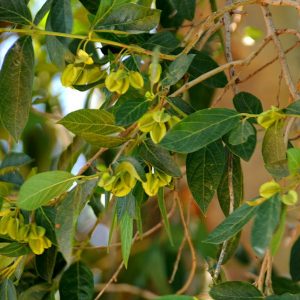
Combretum erythrophyllum.Photo: JMK. Source: Wikipedia
Combretum erythrophyllum grows along the banks of the Umgusa providing high perches for the large birds of prey as few of the other trees gain much height. ‘Erythrophyllum’ means red leaves and refers to the reddish colour they turn in winter before being shed and the fact that the trees essentially riverine explains the common name River Combretum. Peter Steyn comments in “The Ostrich” on having seen Black Tits feeding on grubs in Combretum fruits.
Birds
Tshabalala is great shrike country and 7 species have been seen there, the most striking being the Crimson breasted Shrike with its glorious contrast of crimson, black and white. It is said to be independent of water and thorn bush is its preferred habitat, which is fortunate for us in Bulawayo as we sometimes see it in our gardens. Its distribution is in the west, through South West Africa and Botswana, and only just entering the south west of Zimbabwe. The black cheeked Waxbill has not yet been seen although it too likes thorn bush and one would expect it in that area.
Several migratory species have found the Park to their liking such as Wahlberg’s eagle Yellow-billed Kite, European Roller and the Swallow and there seems to be a suitable niche for all species. There are the river edges for those that like to breed there such as the Golden Weaver, and in the non breeding season birds from the dry areas move in to the river. There are the steep banks for the Kingfishers and others to tunnel and dead trees for the other hole-nesting birds such as Woodpeckers, Barbets and the Kingfishers. Although Kingfishers are well known for their fishing ability some such as the Grey-hooded, the Brown-hooded and the Woodland are insectivorous.
The attractive Tit-babbler with its chestnut coloured under tail coverts has been seen foraging on the ground; Crowned Plovers and Capped wheatears are active in the burnt areas and Pippits occur on the roads. Francolin and Guinea-fowl flocks scratch busily for their varied foods and in January the Great spotted cuckoo was seen on the western boundary of the Park, searching the lower branches for hairy caterpillars. There is a vacant ecological niche for the Oxpeckers but maybe it is only a matter of time for it to be filled considering the enterprising experiment carried out in Hwange Game Park some time ago, when nooses baited with liver paste were dragged through the park on the back of a donkey, with most successful results. The Ox-peckers thus caught were introduced into the Rhodes Matopos Game Park and have since spread about 20 miles northwards, in the direction of Tshabalala.
Grasses
With Acacia trees one finds ‘sweetveld’ i.e. mainly annual grasses which are palatable for grazing animals and bearing seed which is taken by seed-eating birds. In the Park there are areas where Acacia trees have been cleared in years gone by but the sweetveld is still there at certain times attracting herds of animals which make a fine sight. Grasses found which have good forage value are : Digitaria andropogon, Chloris cenchris, Eragrostis, etc.
In the area where Wildebeest and Zebra occur, when the veld has been well grazed in winter, one can see pink tufts of grass standing up alone in the otherwise shortgrass. This is an aromatic and unpalatable grass such as Cymbopogon.
Conclusion
Reference was made at the beginning of this article to the changing nature of Tshabalala. It is a dynamic situation and changes will take place all the time. Seeds may been brought from other regions when the animals were translocated and, with all sorts of other life from far and wide, may still be being brought in by, for example, the migratory birds and the vehicles of visitors.
In the ‘Origin of Species’ Darwin wrote over 100 years ago “It is interesting to contemplate a tangle of plants of many kinds, with birds singing in the bushes, with various insects flitting about, and with worms crawling through the damp earth, and to reflect that these elaborately constructed forms, so different from each other, and dependent upon each other in so complex a manner, have all been produced by laws acting around us.”
At Tshabalala you are permitted to walk about the veld and can reflect on these interactions.
-Janet Webber.
VISIT TO MURAHWAS HILL.
In March 1970 the Tree Society visited Mutare to see the newly opened Nature Reserve on Murahwas Hill and to meet and pay tribute to Norman Chase. At a ceremony on Murahwas Hill a plaque on a large boulder was unveiled to commemorate the occasion and Mr. Chase was given a bookshelf.
I am so glad that happened; so much nicer than waiting until after he died. We had the pleasure of knowing him, one of nature’s perfect gentlemen with an incredible knowledge of plants and exactly where to find each specimen so that he was always being called upon to take visiting botanists to what they wanted to see; his collections of plants, impeccably dried and pressed and labeled, forms a valuable part of material in the National Herbarium.
Norman Chase passed away on 18th November 1970 aged 82 and 12 years later his grave is still unmarked. Paul and I would like to rectify this and I am sure there are others with special memories of him who would like to do so too. I am therefore proposing to open a fund to achieve this objective and if you would like to contribute please do so to the Norman Chase Memorial Fund, P.O. Box 4643 Harare. I must stress that this is a private fund belonging to the contributors and NOT an official activity of the Tree Society.
From Dix and Audrey Airey came Christmas Greetings and a footnote that “If any member is coming to Durban on holiday and would like to see Palmiet, Pigeon Valley or Stainbank Reserve (Yellowwood Park) I should be very glad to show them around. Dix
Their address is 270 Queen Elizabeth Avenue, Manor Gardens, Durban. 4001. RSA and I am sure Dix really would like to meet members from Zimbabwe.
-Meg Coates Palgrave Chairman.
MINUTES OF THE 32ND ANNUAL GENERAL MEETING OF THE TREE SOCIETY OF ZIMBABWE HELD AT THE QUEEN VICTORIA MUSEUM ON THE 26TH JANUARY, 1982 AT 2210 HOURS.
Present : Mrs M. Coates Palgrave in the Chair
Miss P. Walker – Secretary
Mr. I. Milton – Treasurer
Mr. P. Coates Palgrave – Minute Secretary
And 24 others
1 NOTICE CONVENING THE MEETING was read by the Secretary
Apologies : Apologies were received from Mesdames : F. Bell, M. Izzet, L. Phillips and Messrs F. Blackie, K. Damstra and D. Irvine
2 MINUTES OF THE LAST AGM having been circulated were taken as read.
Proposed by B.Best; seconded K .Davey
3 MATTERS ARISING FROM THE MINUTES : The Chairman said that discussion on amendments to the Constitution would be dealt with under item F of the agenda. There were no other matters arising.
4 PRESIDENT’S REPORT : As published in Tree Life No. 24
5 TREASURER’S REPORT : As published in Tree Life No. 24
6 AMENDMENTS TO THE CONSTITUTION : The Chairman distributed copies of her proposed amendments to the Constitution (as attached at Annexure A) and said that she hoped to solve the problem which had arisen last year. In these proposals produced in consultation with the Committee and other involved persons, she was proposing to:
- Delete all reference to President and Vice President, so the executive officers became the Chairman and Vice Chairman
- Delete “Hon’ as referring to the Secretary and Treasurer (see also 6h)
- Make a slight re-arrangement of the whole of Section 9.
- Provide for Honorary Officers to be elected at each AGM for one year, and at each succeeding AGM if the meeting so desires.
- To make provision for the Hon. Auditor to be elected at an AGM as had just been done. It was a decision which should be taken by all the members and not just the Committee
- Douglas Irvine, who had originally proposed the amendment, last year was unfortunately not present due to an important commitment, but by seconding the tabled proposal he had given his support. Mr. Petheram said he would like to amend the wording of Section 9 paragraph 10 to read “Honorary Officers may be elected at an Annual General Meeting in recognition of their outstanding contribution to the objects of the Society.” This was seconded by Mr. J. Reid. The Chairman called for a show of hands and the amendment was agreed by a unanimous vote.
- The Chairman explained, in reply to a question, why it was proposed to delete the ‘Hon’ before the Chairman and Secretary and not before the Auditor. It was because the Hon. Auditor need not be a member of the Society and was a person giving professional services to the Society free of charge. The ‘Hon’ in front of the President carried another meaning of the word in that he or she was being honoured by being elected to the post.
7 ELECTION OF OFFICERS : the following officers were elected
Chairman : Mrs. M. Coates Palgrave; proposed by Miss P. Walker, seconded by Mr.P. Haxen
Vice Chairman : The Chairman said that it was an unwritten rule of the Society that the Chairman would only stand for 2 years so that next year the meeting would have to elect a new Chairman. Usually the Vice-Chairman would follow but in case there was no-one proposed who would be available for the Chair next year she wanted to propose Mrs. L. Irvine as Vice Chairman in recognition of what she had done for the Society, even though she would not be available to be Chairman next year. The Chairman called for nominations, and, as there were none, she proposed Mrs. Irvine which was seconded by Miss P. Walker.
Secretary : Miss P. Walker; proposed by the chairman and seconded by Mr. R. Petheram
Treasurer : Mr. B. Best; proposed by Mrs. I Milton and second by Mr. R. Petheram
Other members of the Committee : Mesdames. S. Duncanson C. Haxen; Messrs. G. Hall, P. Coates Palgrave, Mr. A. Dry; Mr. P. Haxen
8 ANY OTHER BUSINESS : Mr. Petheram proposed a vote of thanks and congratulations to the Chairman for a “fantastically successful, stimulating and invigorating year”. This received acclaim from the members present.
There being no further business the meeting closed at 2255 hours.
Confirmed and signed this ……… day of ……………………………………….1983


